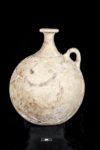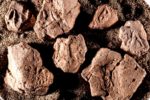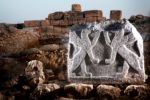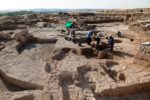 A team of Turkish and Italian archaeologists have discovered what may be the first known smiley face in the ancient city of Karkemish in Turkey’s southeastern province of Gaziantep near the border with Syria. The terminally cheery curved line topped by two dots was painted on the side of pitcher around 3,700 years ago.
A team of Turkish and Italian archaeologists have discovered what may be the first known smiley face in the ancient city of Karkemish in Turkey’s southeastern province of Gaziantep near the border with Syria. The terminally cheery curved line topped by two dots was painted on the side of pitcher around 3,700 years ago.
“The smiling face is undoubtedly there (there are no other traces of painting on the flask) and has no parallels in ancient ceramic art of the area,” [excavation leader Dr. Nicolo Marchetti of Bologna University] said. […]
The unusual pitcher in question was originally off-white in colour and features a short thin neck, wide body and small handle. Found in a burial chamber, it was used for a sweet sherbet-like drink, and dates back to 1,700 BC.
Archaeologists only realised the smile was there when the pot was taken to a lab for restoration work, Turkish news agency Anadolou reported.
Occupied from the 6th millennium B.C. until it was abandoned in the late Middle Ages, the remains of Karkemish were first discovered and excavated in the late 19th century. Some illustrious figures — T.E. Lawrence, Leonard Woolley, Gertrude Bell — participated in later digs before and after World I. Even with this long history of archaeological exploration, the site still had much to reveal. The joint Turkey and Italian team has been excavating Karkemish every year since 2011. The smiley pitcher was found this season, which began on May 2nd, and it was not the only important discovery.
 The team also unearthed 250 bullae, clay tokens impressed with seals that would be attached to legal and commercial documents as proof identity and authenticity. The seals were found in the late Bronze Age layer and date to the Hittite Empire in the 13th century B.C. when Karkemish was the seat of the Hittite viceroy who controlled the entire region. Among the 250 bullae are the seals of some of the highest ranking individuals in the Hittite administration of the city, most notably that of Taya or Tahe, prince and “charioteer of the goddess Kubaba.” Researchers are excited by the great number of bullae recovered because they hope the seals will reveal new information about the people, trade and administrative systems of Karkemish during its most prosperous period.
The team also unearthed 250 bullae, clay tokens impressed with seals that would be attached to legal and commercial documents as proof identity and authenticity. The seals were found in the late Bronze Age layer and date to the Hittite Empire in the 13th century B.C. when Karkemish was the seat of the Hittite viceroy who controlled the entire region. Among the 250 bullae are the seals of some of the highest ranking individuals in the Hittite administration of the city, most notably that of Taya or Tahe, prince and “charioteer of the goddess Kubaba.” Researchers are excited by the great number of bullae recovered because they hope the seals will reveal new information about the people, trade and administrative systems of Karkemish during its most prosperous period.
 Another exceptional find made in the same area of the city is a large basalt relief of two rampant griffons. It was carved at the end of the 10th century B.C. during the reign of the Neo-Hittite king Katuwa who was better known for his construction and sculptural endeavors than his prowess on the battlefield. The griffon relief is believed to be one of a pair with a relief of a winged bull discovered during last year’s excavation. Archaeologists found significant architectural remains as well, including the remains of a massive fortress and a grain silo, both dating to the end of the Neo-Assyrian period, around 1100 B.C.
Another exceptional find made in the same area of the city is a large basalt relief of two rampant griffons. It was carved at the end of the 10th century B.C. during the reign of the Neo-Hittite king Katuwa who was better known for his construction and sculptural endeavors than his prowess on the battlefield. The griffon relief is believed to be one of a pair with a relief of a winged bull discovered during last year’s excavation. Archaeologists found significant architectural remains as well, including the remains of a massive fortress and a grain silo, both dating to the end of the Neo-Assyrian period, around 1100 B.C.
 Seven season of digs will soon come to a culmination when the site is opened to the public for the first time next year. Karkemish is in a militarily sensitive area and access has long been restricted. The Turkish Minister of Culture and Tourism announced earlier this month that on May 12th, 2018, the site will open its doors as the Karkemish Ancient City Archaeological Park. The smiley jug will go on display at the nearby Gaziantep Museum of Archaeology.
Seven season of digs will soon come to a culmination when the site is opened to the public for the first time next year. Karkemish is in a militarily sensitive area and access has long been restricted. The Turkish Minister of Culture and Tourism announced earlier this month that on May 12th, 2018, the site will open its doors as the Karkemish Ancient City Archaeological Park. The smiley jug will go on display at the nearby Gaziantep Museum of Archaeology.
There is a whole new sense of urgency and meaning behind the excavations and the upcoming archaeological park. On the Syrian side of the border, the civil war has taken an unbearably onerous toll on its rich ancient history. While some of the most precious and beautiful archaeological remains in the world have been brutalized by ISIS and other belligerents in this quagmire from hell, excavation and conservation of ancient material culture has continued undeterred just over the border in Turkey.
An ancient Kool-aid pitcher, too cool. 😆
Robin
Arabic letter “ta” resembles smiley face.
https://unclesmiley.wordpress.com/2011/02/21/smiley-simulacrum-arabic-smiley/
Arabic letter “ta” resembles smiley face.
Myself, I had so far no idea about ‘Kool-Aid’, but there is a Wikipedia treatise on ‘Kool-Aid Man’, and there are indeed similarities 😮
It smiled for 3,700 years, buried alive, refusing to believe it was lost forever…. forever alone… https://imgur.com/gallery/vgikS